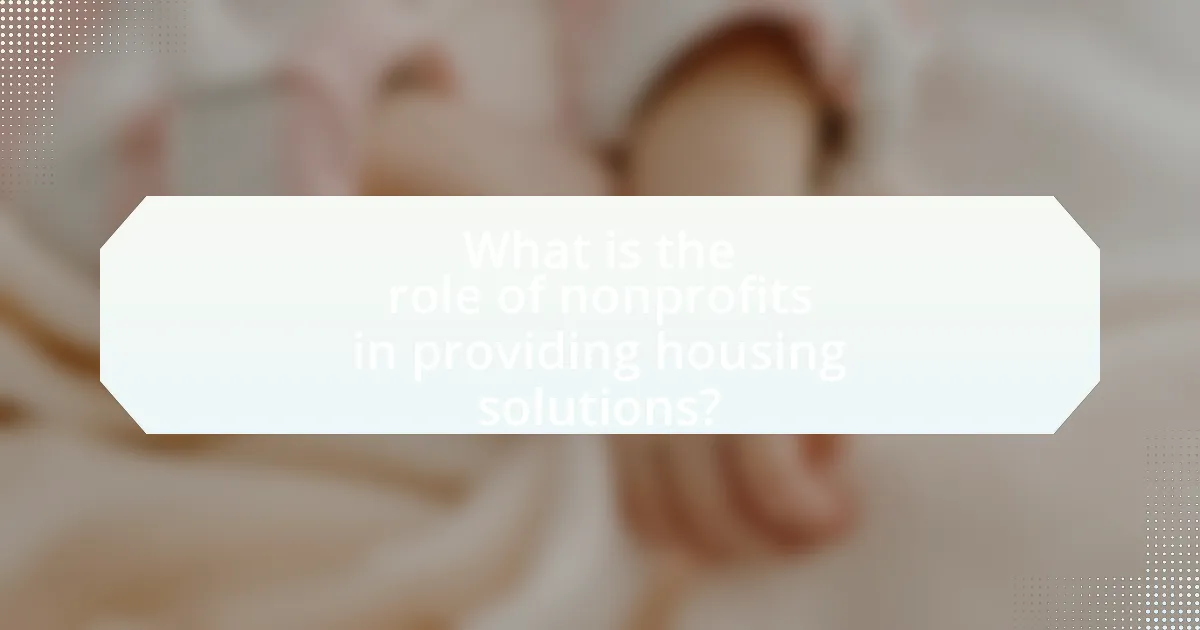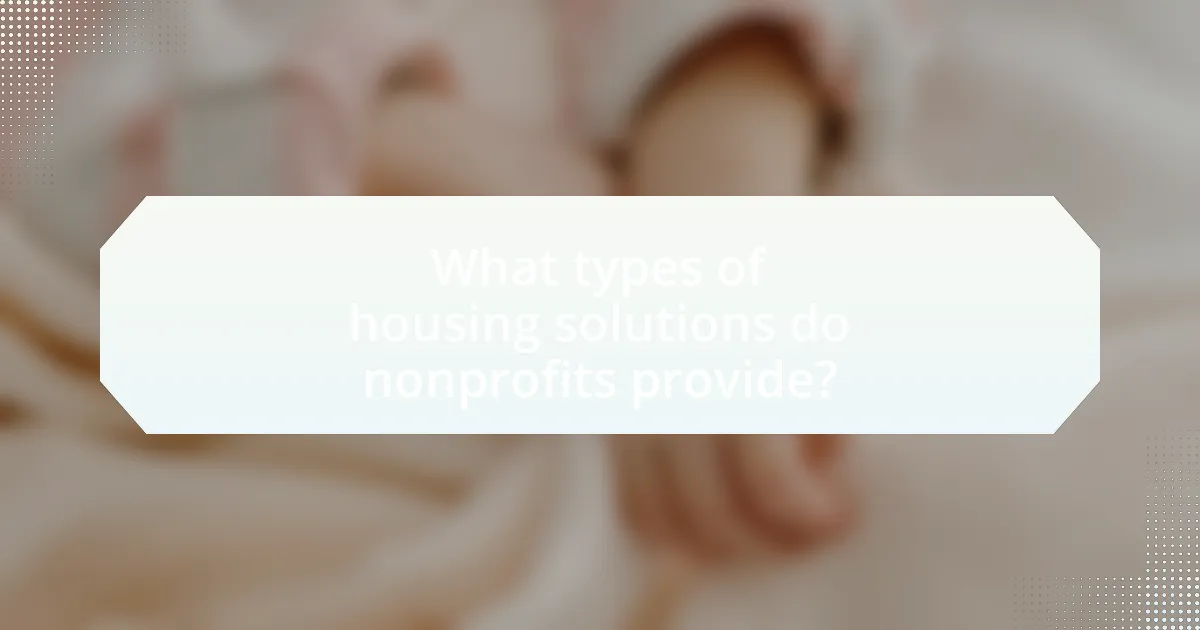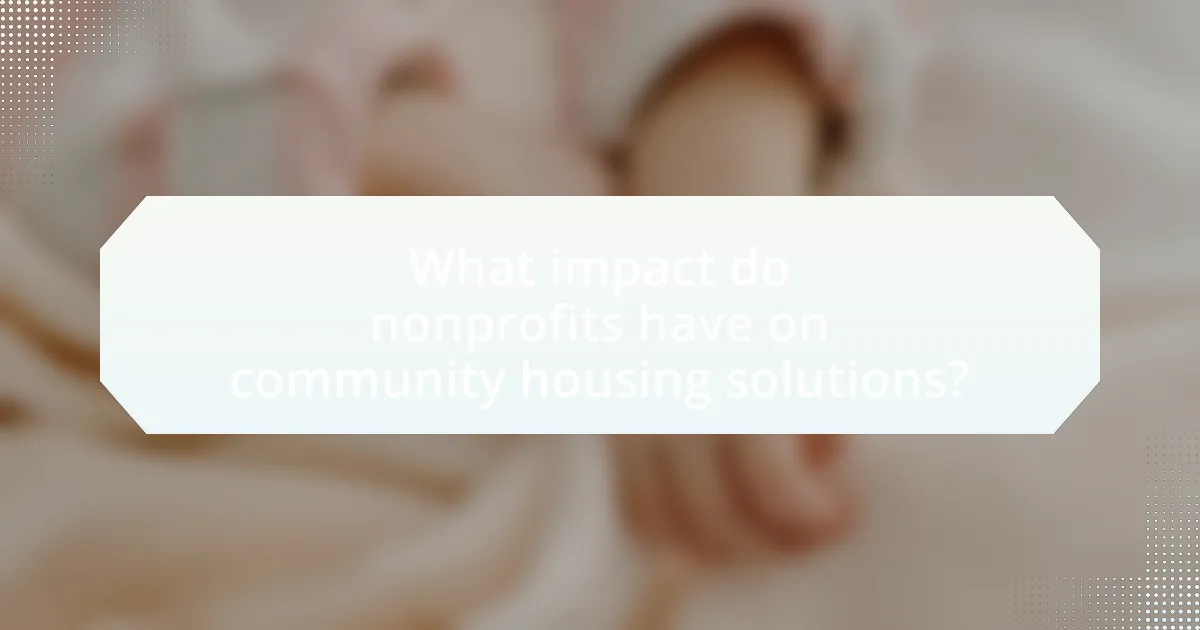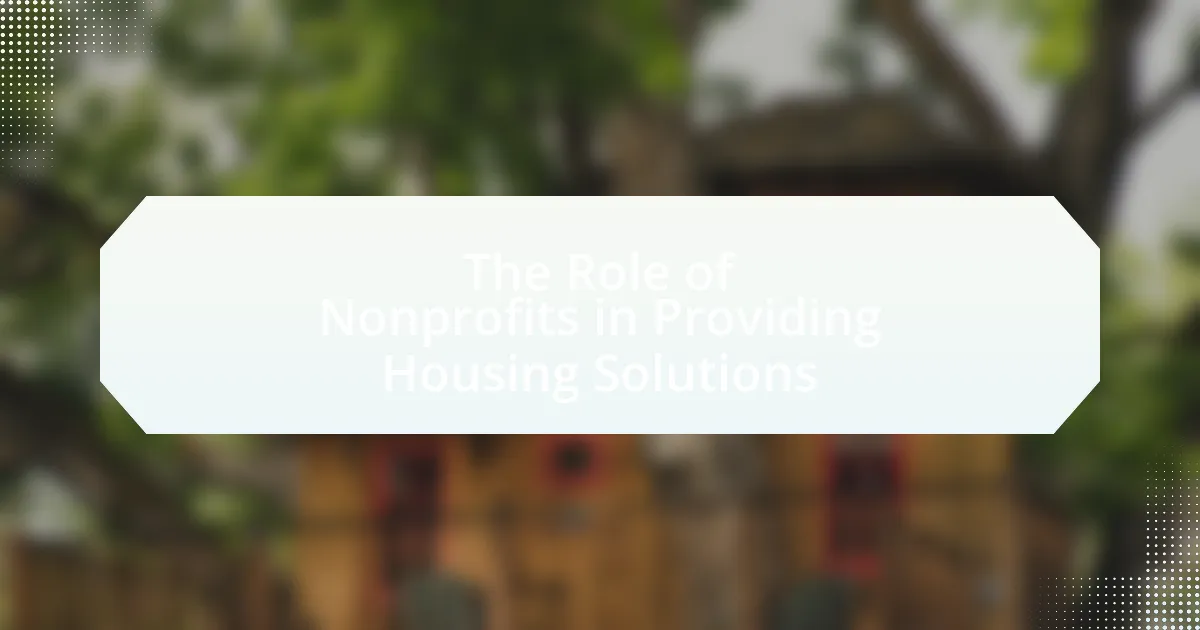Nonprofits play a vital role in providing housing solutions, particularly for underserved populations, by developing affordable housing, offering rental assistance, and advocating for equitable housing policies. They have significantly contributed to housing accessibility, producing over 1.5 million affordable housing units in the United States since 2010. Nonprofits implement various housing programs, including emergency shelters and supportive housing, tailored to meet the specific needs of different communities. Despite facing challenges such as funding limitations and regulatory hurdles, nonprofits collaborate with government and private sectors to enhance housing initiatives and address homelessness effectively. Their innovative strategies and community engagement efforts further amplify their impact on housing solutions and policy reform.

What is the role of nonprofits in providing housing solutions?
Nonprofits play a crucial role in providing housing solutions by addressing the needs of underserved populations and facilitating access to affordable housing. They often engage in activities such as developing low-income housing, offering rental assistance, and advocating for housing policies that promote equity. For instance, organizations like Habitat for Humanity have built over 1 million homes globally, demonstrating their impact on housing availability. Additionally, nonprofits frequently collaborate with government agencies and private sectors to leverage resources and create comprehensive housing programs, further enhancing their effectiveness in tackling housing challenges.
How do nonprofits contribute to housing accessibility?
Nonprofits contribute to housing accessibility by developing affordable housing projects and advocating for policy changes that support low-income individuals. These organizations often leverage funding from government grants, private donations, and partnerships to create housing options that are financially accessible to underserved communities. For instance, according to the National Low Income Housing Coalition, nonprofits have played a crucial role in producing over 1.5 million affordable housing units in the United States since 2010. Additionally, nonprofits engage in community organizing and education efforts to raise awareness about housing rights, further enhancing accessibility for those in need.
What specific housing programs do nonprofits offer?
Nonprofits offer a variety of specific housing programs, including affordable housing development, emergency shelter services, transitional housing, and housing assistance programs. Affordable housing development programs focus on creating low-cost housing options for low-income families, often utilizing government grants and private donations. Emergency shelter services provide immediate housing for individuals and families facing homelessness, ensuring safety and basic needs are met. Transitional housing programs assist individuals in moving from homelessness to permanent housing by providing temporary accommodations and support services. Housing assistance programs, such as rental assistance and homebuyer education, help families secure stable housing through financial support and guidance. These programs are essential in addressing housing insecurity and promoting community stability.
How do these programs address the needs of different communities?
Nonprofit housing programs address the needs of different communities by tailoring their services to specific demographic and socioeconomic factors. For instance, programs often focus on low-income families, the elderly, or individuals experiencing homelessness, providing affordable housing options and supportive services that meet their unique challenges. Research from the National Low Income Housing Coalition indicates that in 2021, there was a shortage of 7 million affordable rental homes for extremely low-income renters, highlighting the critical need for targeted housing solutions. By collaborating with local governments and community organizations, these programs can effectively identify and respond to the distinct needs of various populations, ensuring that resources are allocated where they are most needed.
Why are nonprofits essential in the housing sector?
Nonprofits are essential in the housing sector because they address gaps in affordable housing and provide critical services to underserved populations. These organizations often focus on community needs, advocating for low-income families and individuals who struggle to find safe and affordable housing options. According to the National Low Income Housing Coalition, there is a shortage of 7 million affordable rental homes for extremely low-income renters, highlighting the crucial role nonprofits play in bridging this gap through development, advocacy, and support services. Nonprofits also leverage public and private funding to create housing solutions that might not be financially viable for for-profit entities, ensuring that vulnerable populations have access to stable housing.
What unique advantages do nonprofits have over for-profit organizations?
Nonprofits have unique advantages over for-profit organizations primarily due to their mission-driven focus and access to diverse funding sources. Nonprofits prioritize social impact over profit maximization, allowing them to address community needs more effectively, particularly in housing solutions. For instance, nonprofits can secure grants and donations that are not available to for-profit entities, enabling them to offer services at lower costs or even for free. According to the National Council of Nonprofits, nonprofits receive approximately $450 billion annually in charitable contributions, which significantly enhances their capacity to implement housing initiatives. Additionally, nonprofits often foster strong community relationships, which can lead to greater trust and collaboration with local stakeholders, further amplifying their effectiveness in providing housing solutions.
How do nonprofits foster community engagement in housing initiatives?
Nonprofits foster community engagement in housing initiatives by actively involving local residents in the planning and decision-making processes. They conduct outreach programs to educate the community about housing issues and encourage participation through workshops, forums, and surveys. For instance, a study by the National Low Income Housing Coalition found that community-driven initiatives led by nonprofits resulted in a 30% increase in local participation in housing projects. This engagement not only empowers residents but also ensures that housing solutions are tailored to meet the specific needs of the community.
What challenges do nonprofits face in providing housing solutions?
Nonprofits face significant challenges in providing housing solutions, primarily due to limited funding and resources. Many nonprofits rely on grants, donations, and government support, which can be inconsistent and insufficient to meet the growing demand for affordable housing. According to the National Low Income Housing Coalition, there is a shortage of 7 million affordable rental homes for extremely low-income renters, highlighting the gap that nonprofits must address with limited financial means. Additionally, regulatory hurdles and zoning laws can complicate the development of new housing projects, further constraining nonprofits’ ability to deliver effective solutions. These challenges underscore the complexities nonprofits encounter in their mission to provide adequate housing.
How do funding limitations impact nonprofit housing efforts?
Funding limitations severely restrict nonprofit housing efforts by reducing the resources available for project development and operational sustainability. Nonprofits often rely on grants, donations, and government funding, and when these sources are limited, their ability to acquire or maintain housing units diminishes. For instance, a report from the National Low Income Housing Coalition indicates that 71% of nonprofit housing organizations cite funding as a primary barrier to expanding their services. This lack of financial support leads to fewer affordable housing options, increased competition for limited resources, and ultimately, a greater number of individuals and families facing housing insecurity.
What regulatory hurdles do nonprofits encounter in housing projects?
Nonprofits encounter several regulatory hurdles in housing projects, including zoning laws, building codes, and funding restrictions. Zoning laws can limit the types of housing that can be developed in certain areas, often requiring nonprofits to navigate complex approval processes. Building codes impose specific construction standards that must be met, which can increase costs and extend timelines. Additionally, funding restrictions from government grants or private donors may impose conditions that complicate project execution, such as compliance with specific regulations or reporting requirements. These challenges can hinder the ability of nonprofits to effectively provide housing solutions.
How do nonprofits collaborate with other organizations for housing solutions?
Nonprofits collaborate with other organizations for housing solutions by forming partnerships that leverage resources, expertise, and networks. These collaborations often involve local governments, private sector entities, and other nonprofits to create comprehensive housing strategies. For example, the National Low Income Housing Coalition reported that partnerships between nonprofits and local governments can lead to the development of affordable housing units, utilizing funding from various sources such as federal grants and private donations. Additionally, nonprofits may engage in joint initiatives with housing developers to increase the availability of low-income housing, demonstrating the effectiveness of collaborative efforts in addressing housing shortages.
What innovative strategies are nonprofits using to enhance housing solutions?
Nonprofits are employing innovative strategies such as community land trusts, cooperative housing models, and partnerships with technology firms to enhance housing solutions. Community land trusts allow communities to collectively own land, ensuring long-term affordability and stability. Cooperative housing models enable residents to manage their own living spaces, fostering community engagement and reducing costs. Additionally, partnerships with technology firms facilitate the development of digital platforms that streamline housing applications and connect individuals with available resources, improving access to housing services. These strategies have been shown to effectively address housing shortages and promote sustainable living environments.

What types of housing solutions do nonprofits provide?
Nonprofits provide various housing solutions, including emergency shelters, transitional housing, affordable housing development, and supportive housing. Emergency shelters offer immediate refuge for individuals and families experiencing homelessness, while transitional housing programs help residents move toward permanent housing by providing temporary accommodations and support services. Affordable housing development initiatives focus on creating low-cost housing options for low-income individuals, and supportive housing combines affordable housing with services that assist residents in maintaining stability, such as mental health support and job training. These solutions are essential in addressing homelessness and housing insecurity, as evidenced by studies showing that supportive housing reduces homelessness by 80% and improves overall well-being for residents.
How do nonprofits address homelessness through housing solutions?
Nonprofits address homelessness through housing solutions by implementing programs that provide affordable housing and supportive services. These organizations often utilize models such as permanent supportive housing, which combines affordable housing with wraparound services like mental health support and job training, effectively reducing homelessness rates. For instance, a study by the National Alliance to End Homelessness found that permanent supportive housing can reduce homelessness by up to 80% for individuals with chronic conditions. Additionally, nonprofits often collaborate with local governments and community stakeholders to secure funding and resources, ensuring sustainable housing solutions that meet the needs of vulnerable populations.
What transitional housing options do nonprofits offer?
Nonprofits offer various transitional housing options, including emergency shelters, supportive housing, and transitional living programs. Emergency shelters provide immediate, short-term accommodation for individuals and families experiencing homelessness, often with access to basic services. Supportive housing combines affordable housing with supportive services, helping residents maintain stability while addressing issues such as mental health or substance abuse. Transitional living programs typically serve specific populations, such as youth aging out of foster care or survivors of domestic violence, offering a structured environment to facilitate the transition to permanent housing. These options are designed to assist individuals in achieving self-sufficiency and stability in their housing situations.
How do permanent supportive housing models work?
Permanent supportive housing models provide long-term housing combined with supportive services to individuals experiencing homelessness, particularly those with disabilities or chronic health issues. These models operate by offering stable, affordable housing while simultaneously delivering access to essential services such as healthcare, mental health support, and job training. Research indicates that this integrated approach significantly reduces homelessness and improves overall well-being; for instance, a study by the National Alliance to End Homelessness found that permanent supportive housing reduces the likelihood of returning to homelessness by 80%.
What role do nonprofits play in affordable housing development?
Nonprofits play a crucial role in affordable housing development by acting as developers, advocates, and service providers. They often leverage public and private funding to create and manage affordable housing projects, addressing the needs of low-income communities. For instance, according to the National Low Income Housing Coalition, nonprofits are responsible for developing approximately 30% of all affordable housing units in the United States. This involvement not only increases the availability of affordable housing but also ensures that these developments are tailored to the specific needs of the communities they serve.
How do nonprofits partner with local governments for affordable housing projects?
Nonprofits partner with local governments for affordable housing projects by collaborating on funding, planning, and implementation strategies. These partnerships often involve nonprofits applying for government grants or subsidies, which can provide essential financial resources for housing developments. For example, the Low-Income Housing Tax Credit program, administered by local governments, incentivizes nonprofits to create affordable housing by offering tax credits for eligible projects. Additionally, nonprofits may engage in joint ventures with local governments to leverage land use and zoning regulations, facilitating the development of affordable housing units. This collaborative approach not only enhances resource allocation but also aligns community needs with government objectives, ultimately increasing the availability of affordable housing options.
What financing mechanisms do nonprofits utilize for housing development?
Nonprofits utilize various financing mechanisms for housing development, including grants, low-income housing tax credits, and public-private partnerships. Grants from government entities and foundations provide essential funding for project initiation and operational costs. Low-income housing tax credits incentivize private investment in affordable housing by offering tax reductions, which can significantly lower financing costs. Public-private partnerships enable nonprofits to collaborate with government and private sectors, leveraging resources and expertise to enhance housing development efforts. These mechanisms collectively support the mission of nonprofits to create affordable housing solutions.
How do nonprofits support vulnerable populations in housing?
Nonprofits support vulnerable populations in housing by providing affordable housing options, advocacy, and essential services. These organizations often develop and manage low-income housing projects, ensuring that individuals and families have access to safe and stable living conditions. For instance, the National Low Income Housing Coalition reports that nonprofits play a crucial role in creating over 100,000 affordable housing units annually in the United States. Additionally, nonprofits offer support services such as financial counseling, job training, and legal assistance, which help residents maintain their housing stability and improve their overall quality of life.
What specific services do nonprofits provide for low-income families?
Nonprofits provide a range of specific services for low-income families, including affordable housing assistance, food distribution, financial literacy programs, and access to healthcare services. These organizations often facilitate housing solutions by offering subsidized rental units, emergency shelter, and homeownership programs, which help families secure stable living conditions. For instance, according to the National Low Income Housing Coalition, over 10 million low-income renters face severe housing cost burdens, highlighting the critical role nonprofits play in addressing this issue. Additionally, food banks operated by nonprofits serve millions of families annually, ensuring access to nutritious meals. Financial literacy programs offered by nonprofits empower families to manage their finances effectively, while partnerships with healthcare providers enable access to essential medical services, further supporting the well-being of low-income families.
How do nonprofits assist individuals with disabilities in finding housing?
Nonprofits assist individuals with disabilities in finding housing by providing resources, advocacy, and support services tailored to their specific needs. These organizations often offer housing search assistance, helping individuals navigate the complexities of the housing market, including identifying accessible housing options and understanding tenant rights. Additionally, nonprofits may provide financial assistance for rent or utilities, ensuring that individuals can afford suitable living arrangements. According to the National Council on Independent Living, nonprofits play a crucial role in promoting inclusive housing policies and advocating for the rights of individuals with disabilities, thereby enhancing their access to safe and affordable housing.

What impact do nonprofits have on community housing solutions?
Nonprofits significantly impact community housing solutions by providing affordable housing options, advocating for policy changes, and mobilizing community resources. These organizations often develop and manage low-income housing projects, which directly address the housing crisis faced by many communities. For instance, according to the National Low Income Housing Coalition, nonprofits have created over 1.5 million affordable housing units across the United States, demonstrating their crucial role in alleviating housing shortages. Additionally, nonprofits engage in advocacy efforts that influence local and state housing policies, ensuring that the needs of low-income residents are represented. This multifaceted approach not only increases the availability of affordable housing but also fosters community engagement and empowerment.
How do nonprofits influence local housing policies?
Nonprofits influence local housing policies by advocating for affordable housing initiatives and engaging in community organizing. These organizations often conduct research to highlight housing needs, mobilize community members to voice their concerns, and collaborate with local governments to shape policy decisions. For instance, a study by the National Low Income Housing Coalition found that nonprofits play a critical role in pushing for legislation that increases funding for affordable housing programs, demonstrating their impact on policy outcomes.
What advocacy efforts do nonprofits engage in for housing reform?
Nonprofits engage in various advocacy efforts for housing reform, including lobbying for policy changes, raising public awareness, and providing legal assistance. These organizations often work to influence legislation that promotes affordable housing, tenant rights, and anti-discrimination measures. For example, the National Low Income Housing Coalition advocates for increased funding for affordable housing programs and has successfully influenced federal policy to secure billions in housing assistance. Additionally, nonprofits frequently conduct research and publish reports to highlight housing issues, thereby informing policymakers and the public about the need for reform.
How do nonprofits measure their impact on housing solutions?
Nonprofits measure their impact on housing solutions through various quantitative and qualitative metrics. They often utilize data collection methods such as surveys, interviews, and case studies to assess the effectiveness of their programs. For instance, organizations may track the number of individuals or families housed, improvements in housing stability, and changes in community well-being. Additionally, they may analyze pre- and post-intervention data to evaluate outcomes, such as reduced homelessness rates or increased access to affordable housing. Research indicates that effective measurement frameworks, like the Logic Model, help nonprofits systematically evaluate their impact by linking activities to desired outcomes, thereby providing concrete evidence of their contributions to housing solutions.
What best practices can nonprofits adopt for effective housing solutions?
Nonprofits can adopt several best practices for effective housing solutions, including community engagement, collaboration with local governments, and data-driven decision-making. Community engagement ensures that housing solutions are tailored to the specific needs of residents, fostering trust and participation. Collaboration with local governments can enhance resource sharing and streamline processes, as evidenced by successful partnerships in cities like San Francisco, where nonprofits and government agencies have worked together to increase affordable housing stock. Data-driven decision-making allows nonprofits to assess housing needs accurately and allocate resources efficiently, supported by studies showing that organizations using data analytics improve their program outcomes by up to 30%.
How can nonprofits leverage technology to improve housing services?
Nonprofits can leverage technology to improve housing services by utilizing data management systems, online platforms for resource sharing, and mobile applications for client engagement. Data management systems enable nonprofits to track housing needs and service outcomes effectively, allowing for better allocation of resources and targeted interventions. Online platforms facilitate collaboration among various stakeholders, including housing providers, funders, and clients, enhancing communication and service delivery. Mobile applications can provide clients with real-time information about available housing options, application processes, and support services, thereby increasing accessibility and engagement. These technological tools have been shown to streamline operations and improve service delivery in various nonprofit housing initiatives, leading to more efficient and effective housing solutions.
What community partnerships are most effective for nonprofits in housing?
Effective community partnerships for nonprofits in housing include collaborations with local government agencies, housing authorities, and private sector developers. These partnerships enhance resource sharing, streamline access to funding, and facilitate the development of affordable housing projects. For instance, the National Low Income Housing Coalition reports that partnerships between nonprofits and local governments can lead to the successful implementation of housing initiatives, as seen in various cities where joint efforts have resulted in increased affordable housing stock and improved community services.
What are the future trends for nonprofits in housing solutions?
Future trends for nonprofits in housing solutions include increased collaboration with private sectors, a focus on sustainable and affordable housing, and the integration of technology in service delivery. Nonprofits are increasingly partnering with businesses to leverage resources and expertise, which enhances their capacity to address housing challenges effectively. Additionally, there is a growing emphasis on environmentally sustainable practices, as seen in initiatives that promote green building standards and energy-efficient designs. The use of technology, such as data analytics and digital platforms, is also becoming prevalent, enabling nonprofits to better assess community needs and streamline operations. These trends are supported by research indicating that collaborative models and innovative approaches significantly improve housing outcomes and community impact.
How are nonprofits adapting to changing housing market dynamics?
Nonprofits are adapting to changing housing market dynamics by diversifying their funding sources and leveraging partnerships with local governments and private sectors. For instance, many organizations are increasingly utilizing social impact bonds and community land trusts to secure financing and stabilize housing costs. According to a report by the National Alliance to End Homelessness, nonprofits have also expanded their service offerings to include supportive housing and rental assistance programs, which address the immediate needs of vulnerable populations amid rising housing prices. This strategic shift enables nonprofits to remain responsive to market fluctuations and effectively serve communities facing housing instability.
What role will nonprofits play in addressing climate change and housing?
Nonprofits will play a crucial role in addressing climate change and housing by implementing sustainable building practices and advocating for policies that promote environmentally friendly housing solutions. These organizations often focus on developing affordable housing that incorporates energy-efficient designs and renewable energy sources, thereby reducing carbon footprints. For instance, the U.S. Green Building Council reports that green buildings can reduce energy consumption by up to 30% compared to traditional structures. Additionally, nonprofits engage in community education and mobilization efforts to raise awareness about the impacts of climate change on housing stability, ensuring that vulnerable populations are prioritized in climate resilience strategies.

Leave a Reply